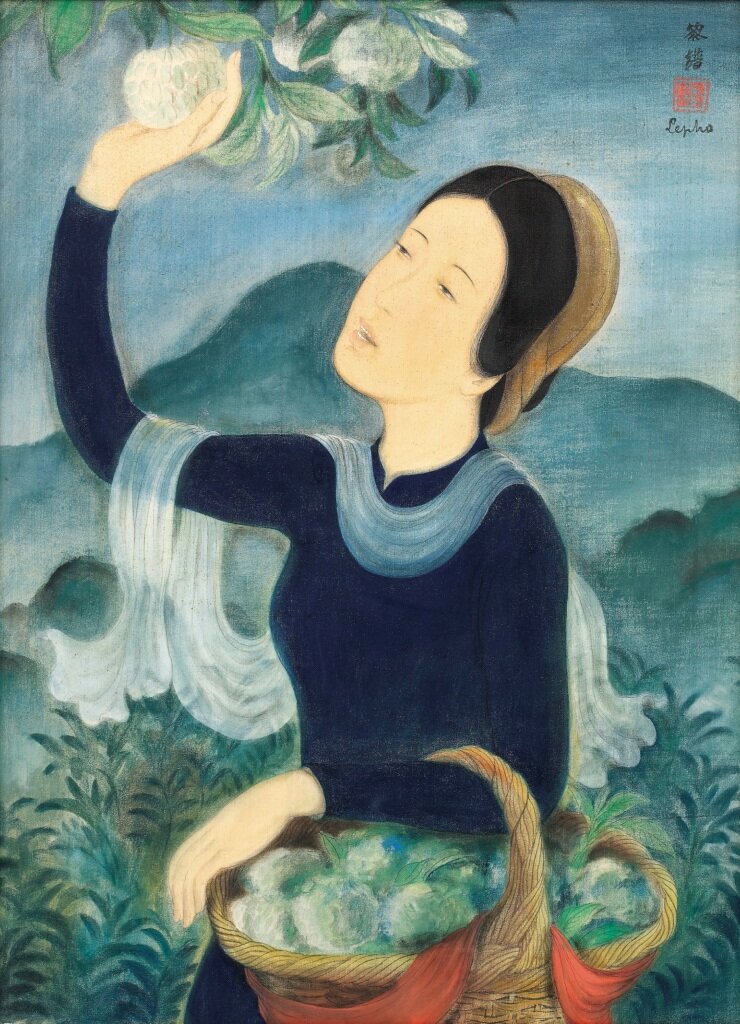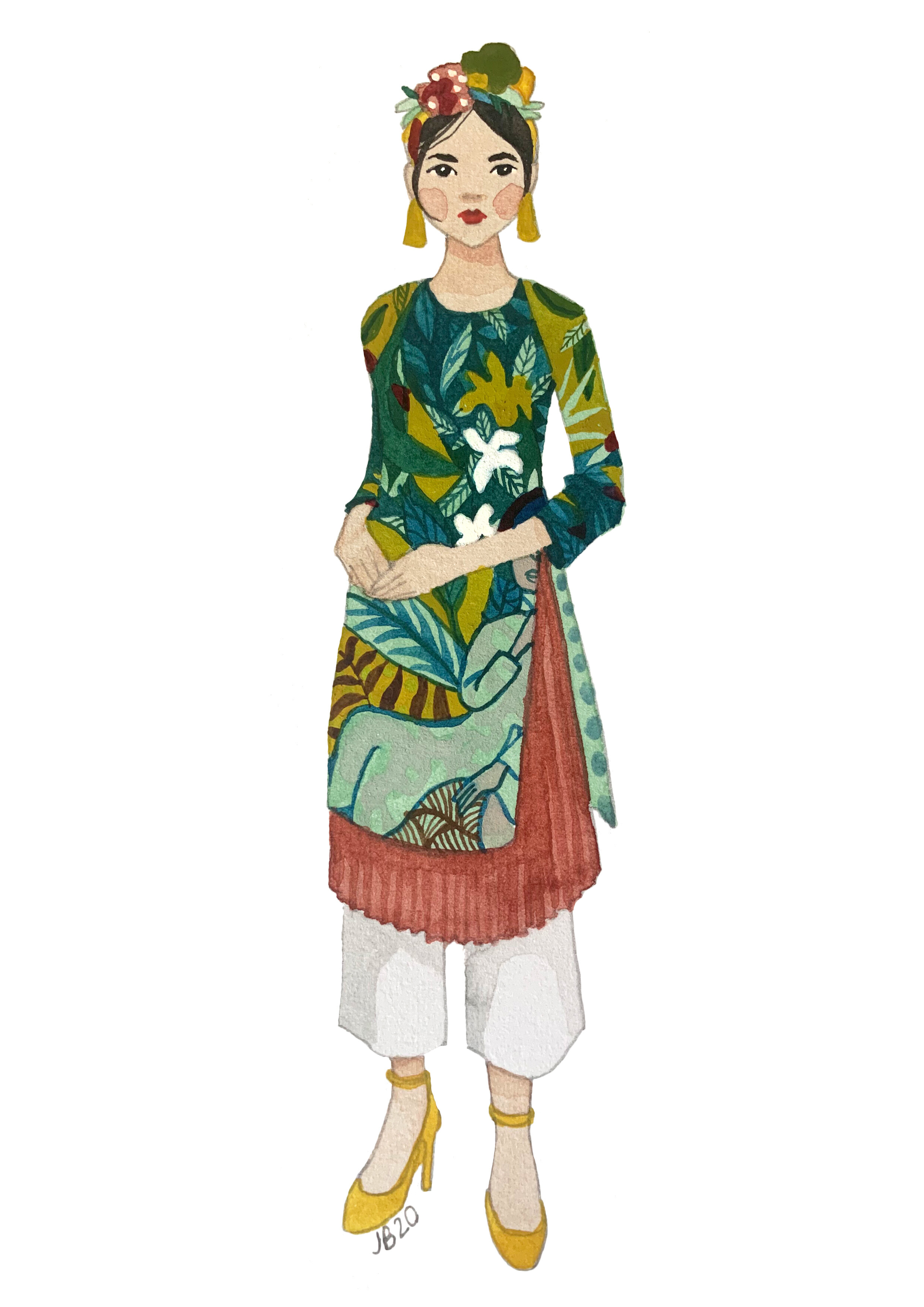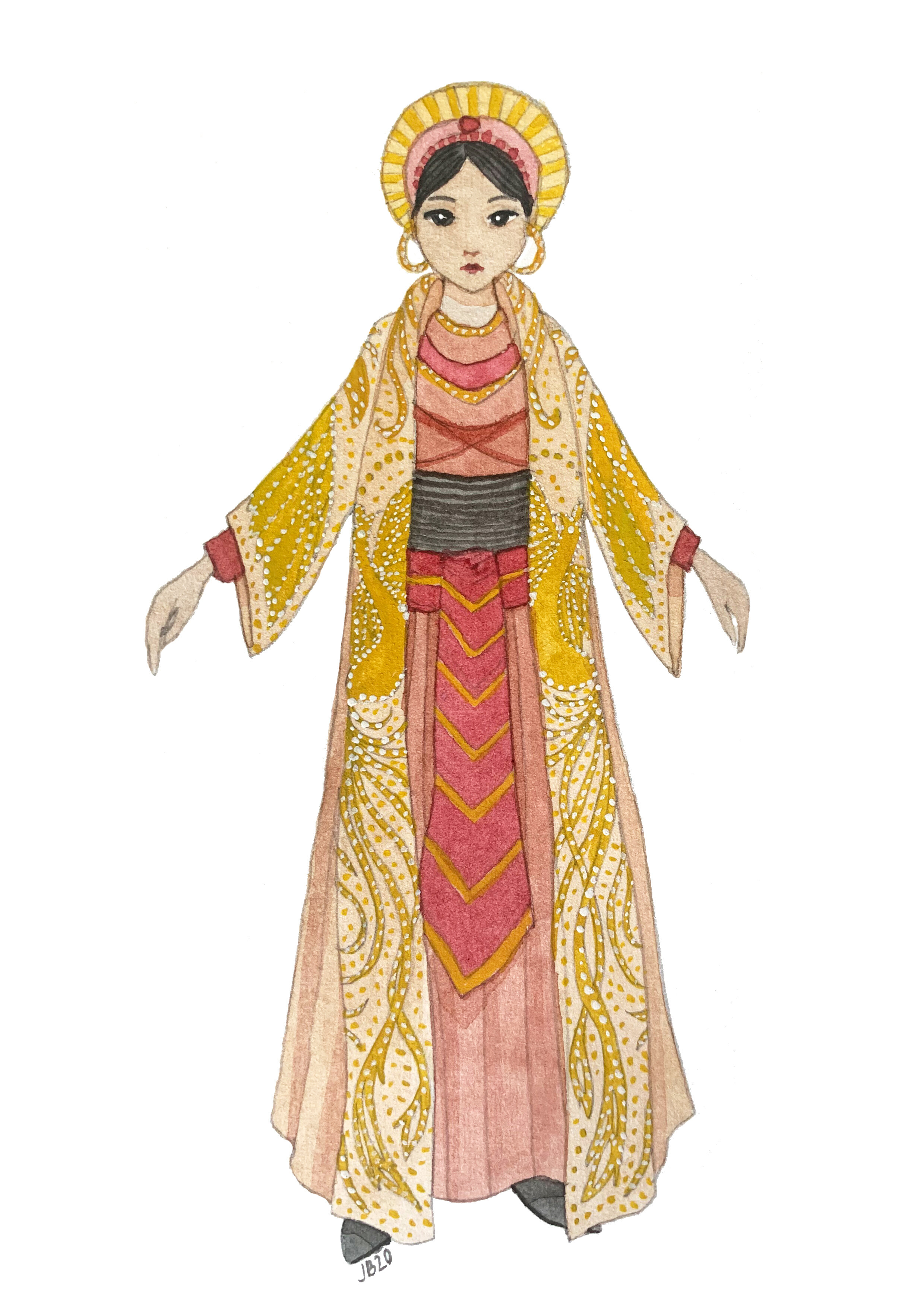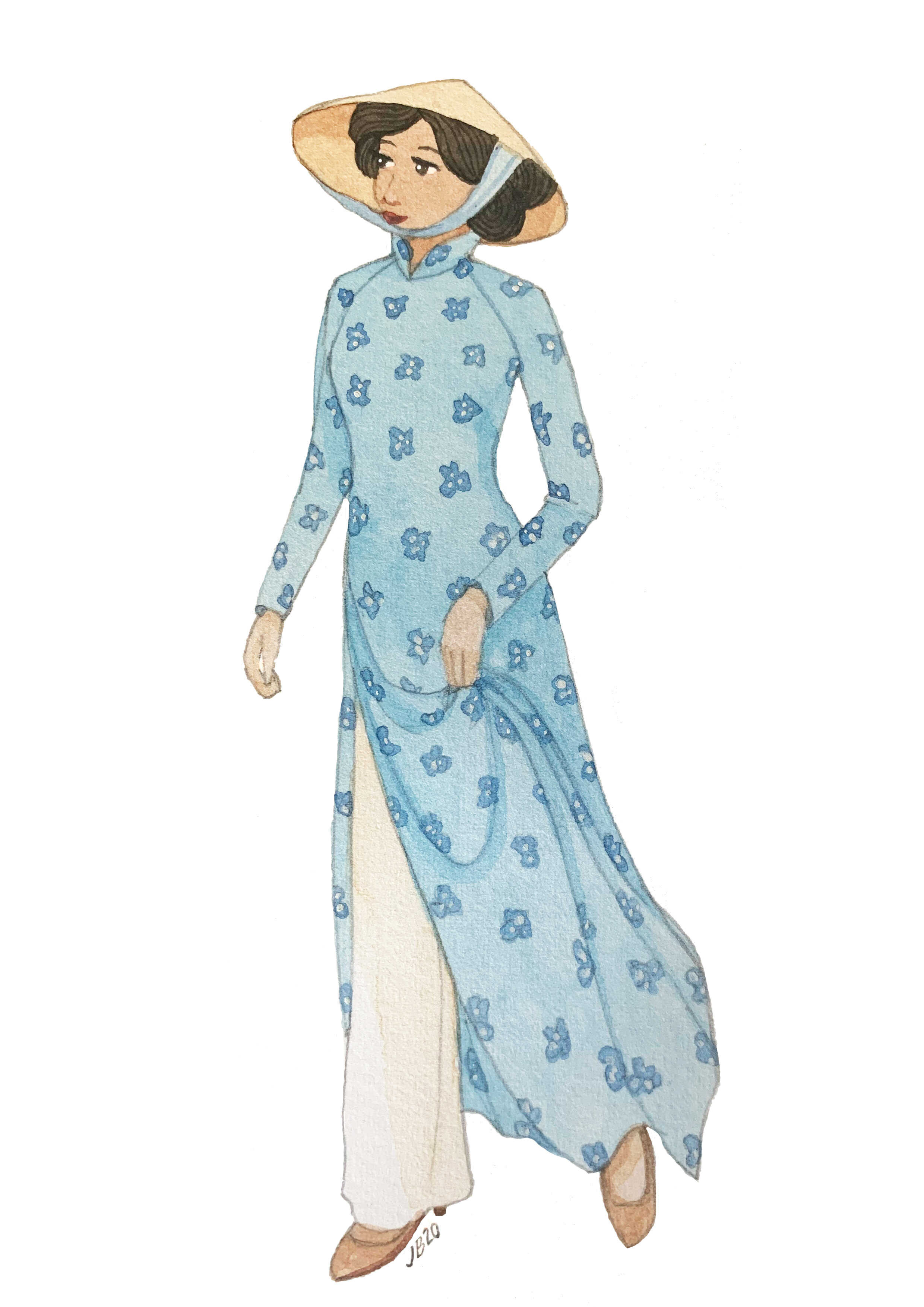Ao Dai - The Evolution
Source: Le Pho, The Lady With Custard Apples
“The ao dai both follows the beautiful lines of the body and flatters it by lending it a sense of fluid movement it does not have. There, the eye only sees the wind, the fluid grace, and the blithe fluttering.”
-Writer, Vo Phien.
Its construction is simple yet classic, illustrating the hallmark of brilliant design. The Ao Dai is a symbol of beauty and femininity.
With long sleeves, typical high mandarin collar and buttons that extend from the collar, slanting to the front of the shoulder then down to the side of the waist, the top portion of the Ao Dai speaks volume about the value of modesty without losing elegance. At the waist, the dress becomes looser with a front and back flap that goes down to the knee and beyond, facilitated by a slit. Ao Dai can be worn with loose-fitting pants, customarily in black or white colour.
The Ao Dai is a symbol of beauty and femininity. As an unofficial national costume, it bears the pride of Vietnam while paying homage to the history of the country. The origin of this iconic folk dress can be traced back to 2000 years ago and it has since gone through significant phases of evolution that mirrors the political climate and cultural circumstance of each era.
BORN OUT OF DRUMS AND WAR
The creation of the Ao Dai might not be so definitive, but it has been linked to the Dong Son culture that flourished during the Bronze Age, before the Han Chinese infiltrated Vietnam. Ao Dai, with its trademark two-flap tunics, was observed in intriguing motifs on antique drums, which might indicate its existence from thousands of years ago.
Another storied beginning tells the tale of the Trung sisters, two heroines who valiantly led a revolution against the Chinese Han dynasty, spearheading the independence of Vietnam.
The Trung sisters donned the flapped Ao Dai and rode onto the battlefield on the backs of elephants, fearlessly fighting off the oppressors. Amidst the turbulent times of war, the details of the Trung sisters’ Ao Dai dresses were etched in the memory of the people. An overcoat in the colour of pale sunset enfolded the Ao Dai that was tinted in deep amber. Phoenix, a symbol of nobility, duty and righteous, was embroidered in blazing scarlet over the collar and along the sleeves.
As a way to show respect and admiration for this pair of courageous sisters, the women started wearing similar four-flapped dresses known as Ao Tu.
ECHOES FROM THE 18TH CENTURY AND 19TH CENTURIES
Fast forward to the 18th and 19th century, Vietnam was divided into two regions, the north and south. The clothing worn by the people was also different.
North: A Distinction Of Class
In the north, the Trinh lords of Hanoi enforced the wearing of a garment known as Ao Giao Linh on their subjects. This costume, featuring a front-buttoned gown and long skirt, was a reminiscent of the robe worn by the Chinese Han people.
Here is where the Ao Dai we know of today went through a major transformation, owing to the need to differentiate between two social classes.
The upper-class women in the 1800s wore Ao Ngu Than, a five-panelled gown made up of four outer flaps, with two sewn up in the front and two at the back. An additional hidden flap with collar details took the place of a bra, which was not yet invented at that time. The slits of the panel would later become a defining feature of the Ao Dai, which we still see today.
The working-class women, in contrast, wore a more functional design known as Ao Tu Than, which was a four-panelled gown, a derivative of the Ao Ngu Than. In this dress, the font panels were not sewn up. Instead they could be tied together. The Ao Tu Than, like many other lower-class clothing of that era, was mainly available in dark colours.
Both dresses had loose silhouettes and were shorter than present-day Ao Dai, most likely due to the lack of modern sewing tools.
South: Royal Attire
In the south in 1744, King Nguyen Phuc Khoat ordered his subjects to wear long silk gown and trousers so as to distinguish between the northern and southern courtiers. The design of the attire was a blend of Han Chinese and southern Champa style, which further evolved into the very first version of the Ao Dai.
TURN OF THE 20TH CENTURY
In the early 20th century, the Ao Dai still retained the loose silhouette from previous eras, but the collar was open to allow the women to show off the necklaces they wore.
1930s - 1950s - LE MUR AO DAI - INFLUENCE FROM THE WEST
In the period from 1930 to 1950s, French colonisation brought waves of Western influence into Vietnam, which eventually unfurled into the arena of fashion. Hanoian artist Cat Tuong (Lemur) infused the inspiration he gained from the west and creatively varied the Ao Dai with different silhouettes.
The Ao Dai was tightened to fit and mould around the women’s bodies. Shoulders were raised and Western details like puffy sleeves, heart-shaped collar, and bows were incorporated. The dress was also lengthened to drape towards the floor. Shifting away from plain, dark tones, the fabrics selected were vibrant and bright.
Women were wearing more flattering designs in the Ao Dai, which made them appear sensual and aesthetically appealing. While the Ao Dai grew in popularity, it also met with criticism of being too sexy and inappropriate for local culture.
AO DAI LE PHO - RETURN TO TRADITION
The progression of the Ao Dai then took a step back to tradition. Painter Le Pho adjusted the Ao Dai Lemur into a more conservative look. Puffy sleeves were replaced with details from the modest Ao Ngu Than and Ao Tu Than. The flaps were retained, the bodice was fitted and the collars were closed around the neck - a resulting look that was acceptable for that time period.
Le Pho was a painter who studied at the École des Beaux, under the instruction of Victor Tardie, a friend and companion of Henri Matisse. Throughout the 1940s Le Pho used thin brushes and painted on silk. Le Pho’s style and technique during this period shows the influence of Chinese art.
Le had three main art periods, which shows his diversity as an artist. Subjects he often depicted in his works were scenery of Vietnam, still life with flowers, family settings and portraits. Women were often portrayed as elongated figures, with surrealist features, somewhat ethereal, which are recurrent themes in his work.
Friends recount that “although he had lived in France his soul had always remained in Vietnam.”
THE CONTROVERSY OF THE V-NECK DRESS
By the time the 1950s came to an end, the political landscape was once again changing. As one western force departed, another arrived. United States with its ideals of capitalism and modernisation was causing a stir on all fronts.
In 1958, the Ao Dai landed in the eye of a storm. Tran Le Xuan, the wife of the president's chief adviser, made a controversial fashion appearance by wearing a V-neck collared Ao Dai dress with short sleeves and gloves. While she was praised by some for the elegant look, many were offended. The government had to ban the dress because it appeared as an act of acceptance of everything which the United States stood for.
1960s: DUNG DAKAO’S NEW DESIGN
In the 1960s, the popularity of the Ao Dai reached its pinnacle, especially in the south. Dung Dakao, a Saigon-based designer altered the traditional costume, adding raglan sleeves and connected the front panel of the Ao Dai to the back, with the ingenious use of buttons that went from the collar to the armpit and all the way down to the hip. This created a comfortable dress that was snug on the female body while showing fewer wrinkles; an ode to freedom in movement.
1970s - 1980s: MODERNISED MINI VERSION
“Live fast, die young” was the motto of the era, where the country saw a reform Doi Moi period while witnessing the rise of hippie culture. Ao Dai was modernised, this time morphing into a mini version, as if to rebel against yet another wave of change. Lighter materials were used while showcasing vivid colours, modish geometrical shapes and botanical prints. The collar was lower and the bodice was narrower than before. It was also shortened to the knee, and paired with wide bell-bottom pants. This trend continued all the way to the 1990s.
AO DAI IN THE 21ST CENTURY
The Ao Dai is not worn on a daily basis nowadays, but it has cemented its status as the national symbol of grace, beauty, cultural pride, and creativity. Contemporary artists like Si Hoang illustrates Vietnamese paintings on the Ao Dai dresses while fashion designer Minh Hanh works with handwoven Hill tribe fabrics to showcase the heritage of Vietnam. The silhouette of a traditional Ao Dai was recently altered by award-winning designer Thuy Nguyen, acclaimed for her exclusive use of Vietnamese silk brocade.
The evolution of the Ao Dai will not stop here. It has transcended time, survived and flourished through war and peace, continually inspiring each generation of designers. There is no doubt why the Ao Dai is such a treasured, timeless element of the Vietnamese culture - now and forever.
To discover more on Vietnamese fashion and costumes, sign up for our November Sa Pa Hill Tribes Tour, where we visit the Women’s Museum in Hanoi as part of our riveting itinerary.





